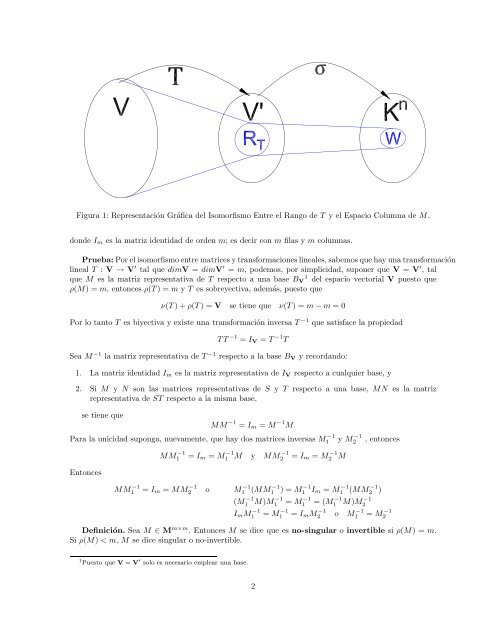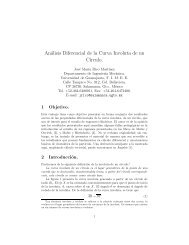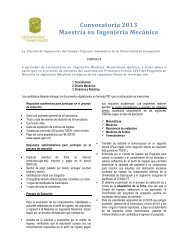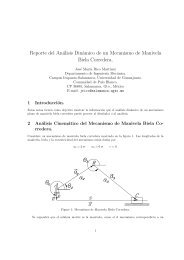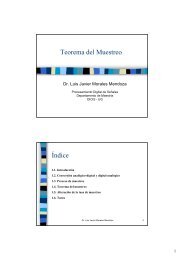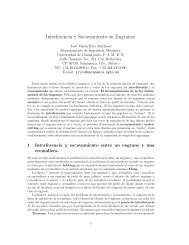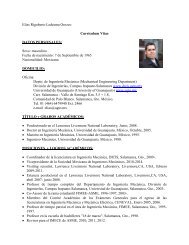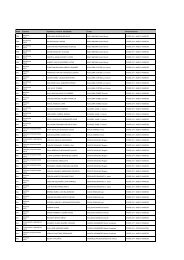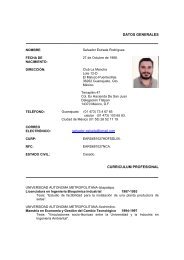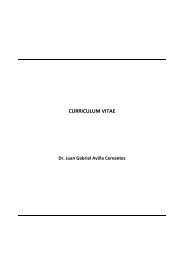Algebra Lineal XIX: Rango de una Matriz y Matriz Inversa.
Algebra Lineal XIX: Rango de una Matriz y Matriz Inversa.
Algebra Lineal XIX: Rango de una Matriz y Matriz Inversa.
You also want an ePaper? Increase the reach of your titles
YUMPU automatically turns print PDFs into web optimized ePapers that Google loves.
Figura 1: Representación Gráfica <strong>de</strong>l Isomorfismo Entre el <strong>Rango</strong> <strong>de</strong> T y el Espacio Columna <strong>de</strong> M.don<strong>de</strong> I m es la matriz i<strong>de</strong>ntidad <strong>de</strong> or<strong>de</strong>n m; es <strong>de</strong>cir con m filas y m columnas.Prueba: Por el isomorfismo entre matrices y transformaciones lineales, sabemos que hay <strong>una</strong> transformaciónlineal T : V → V ′ tal que dimV = dimV ′ = m, po<strong>de</strong>mos, por simplicidad, suponer que V = V ′ ,talque M es la matriz representativa <strong>de</strong> T respecto a <strong>una</strong> base B V 1 <strong>de</strong>l espacio vectorial V puesto queρ(M) =m, entonces ρ(T )=m y T es sobreyectiva, a<strong>de</strong>más, puesto queν(T )+ρ(T )=V se tiene que ν(T )=m − m =0Por lo tanto T es biyectiva y existe <strong>una</strong> transformación inversa T −1 que satisface la propiedadTT −1 = I V = T −1 TSea M −1 la matriz representativa <strong>de</strong> T −1 respecto a la base B V y recordando:1. La matriz i<strong>de</strong>ntidad I m es la matriz representativa <strong>de</strong> I V respecto a cualquier base, y2. Si M y N son las matrices representativas <strong>de</strong> S y T respecto a <strong>una</strong> base, MN es la matrizrepresentativa <strong>de</strong> ST respectoalamismabase,se tiene queMM −1 = I m = M −1 M.Para la unicidad suponga, nuevamente, que hay dos matrices inversas M1 −1 y M2 −1 , entoncesEntoncesMM −11 = I m = M −11 M y MM−1 2 = I m = M −12 MMM1 −1 = I m = MM2 −1 o M1 −1 −11 )=M1 m = M1 −1 2 )(M1 −1 −1M)M1 = M1 −1 =(M1 −1 −1M)M2I m M1 −1 = M1 −1 = I m M2 −1 o M1 −1 = M2−1Definición. Sea M ∈ M m×m . Entonces M se dice que es no-singular o invertible si ρ(M) =m.Si ρ(M)


